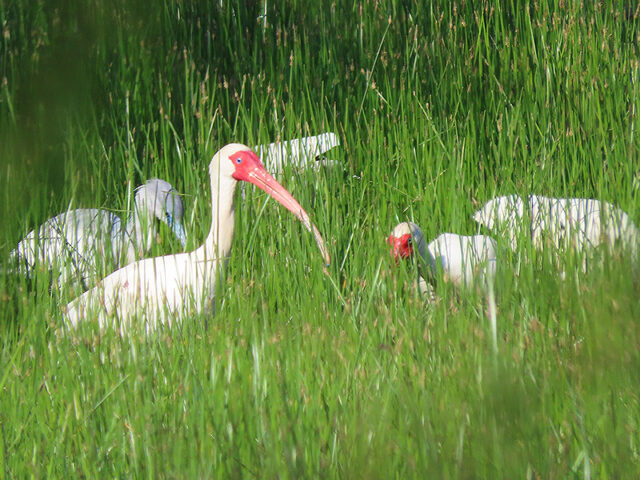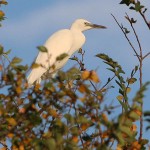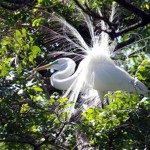Dateline – April 20, 2021 – Lewisville, Texas
Spring showers have flooded a number of the lowland prairies in and around the DFW metroplex. Many different species of urban wildlife are quick to take advantage of these often beneficial changes to their habitat. I keep a sharp eye out for places like the one described in this article as I drive around town. You never know what type of unique wildlife encounter they might present.
On this day I caught a glimpse of a sizable congregation of large white wading birds feeding in a newly reformed wetlands as I drove by this rain soaked field. I pulled over at my first opportunity, grabbed my camera, and positioned myself for a closer look.
Through the bordering band of Black Willows, I could make out an even dozen White Ibis many hundred yards in the distance. The ibis were sporting their long curving bills colored a vivid scarlet for breeding season. With them were a number of immature ibis, and also a nice collection of other wading birds, including Little Blue Herons and Great Egrets.


That’s a Little Blue Heron at the left of frame


It was one of the Great Egrets that caught my attention next. This bird became rapt, with his full attention focused on a prey animal hidden from my view in the tall grass. I always like to spend a little time observing a bird so intent on its hunting activities—it’s often interesting and instructive to get a look at what they capture before it goes down the hatch.
In this case, the Great Egret struck out with its long, yellow bill, and came up with something large and black. Because of the great distance between me and the bird, I could not quite make out what it was that he had captured. At first I assumed crayfish, though I may have caught a glimpse of a snake-like tail thrash as the bird worked to subdue his prey. I took as many pictures as I could before the big bird swallowed the unfortunate critter—whatever it was— whole. I would have to review the photographs back home on the computer to have a chance of identifying the unusual prey species.

At the house I was able to zoom in on the picture enough to get a bit of a surprise. The animal the Great Egret had captured was about 10-12 inches long. It was eel-like in appearance, and was thick throughout its length. The snout was notably blunt, and the skin resembled that of an amphibian—similar to what you might expect on a salamander.





After a little research and consultation the consensus became that this critter is likely a rare type of salamander known as a Lesser Siren. These salamanders have long, eel-like bodies, exposed gills, and only two front legs—rear legs are missing on this species.

Lesser Sirens are able thrive in habitats similar to where this one was observed. They have strategies that help them survive periodic and long term dry spells. Here is what Wikipedia has to say about the unique Lesser Siren…
The lesser siren is nocturnal, spending its days hidden in the debris and mud at the bottom of slow-moving bodies of water. They feed primarily on aquatic invertebrates, including various kinds of worms, insect larvae, snails, and crustaceans. They will also eat the tadpoles and eggs of other amphibians.
Reproduction occurs in the spring, with eggs being laid in shallow depressions at the bottom of calm areas of water, usually surrounded by vegetation, or among plant roots. Though little is known about their courtship, it is believed to be quite violent, as many specimens collected have scarring from healed bite marks from other sirens. About 12-300 eggs are laid at a time, and several clutches may be laid over the course of the year. Hatchlings are only about 0.4 in (1.1 cm) in length, but grow quickly. Maturity is reached in three to four years.
The lesser siren is vocal, unlike most salamanders, and will emit a series of clicks when it approaches others of its species, or a short screeching sound if handled.
If the habitat dries up during the summer, lesser sirens are known to endure droughts by burrowing into the mud. If the mud dries out, they are capable of excreting a substance from their skin which protects them from dehydrating, and enables them to stay buried in dry mud for months until the water returns. Their small legs enable them to move on dry land for short periods of time
Wikipedia – Lesser Siren






